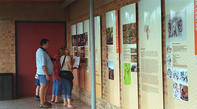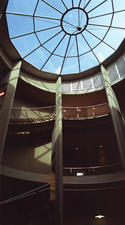A Walk Through Time
The tour through the Sterkfontein caves is, of course, a highlight and should be undertaken by anyone who visits the facility. It is an easy walk, and it is guided so that you will get the most out of your experience underground.

The tour starts at the visitor's centre with an interpretive ‘Walk through time’, which is studded with plaques depicting important moments from the Big Bang to the development of modern humans.
This takes you from the visitor's centre, past the very clever sundial, to the mouth of the caves. Once you have clambered down the stairs, it feels like you have left the 21st century behind you as you enter a timeless world of rock and silence.
The tour takes you past the Silberberg Grotto where Little Foot was found – this is not open to the public for obvious reasons – and on into the heart of the cave. Once inside the atmosphere is cool and still, and the lofty main chamber still has some terrific rock formations that managed to survive the destructive mining activity of the early 20th century.
The tour then leads past the underground lake, which is dark and placid but a bit menacing, for all its beauty. And then through several smaller chambers until you finally emerge, somewhat sadly, back into the sunlight and modernity.
Progress through the caves is relatively easy with good paths, guide rails and appropriate lighting throughout. There is only one short section that requires a bit of crouching (or crawling, depending on how good your knees are). Good walking shoes, jeans and some kind of windbreaker are recommended for your comfort.
Maropeng Visitor's Centre

The various authorities responsible for the Cradle of Humankind have taken the bold step of creating a new and unique visitors centre that will act as a drawcard for the area. It is called Maropeng, meaning ‘returning to the place of origin’ or ‘the place where we all come from’.
It is close to the Sterkfontein Caves and can be easily combined with a tour of the caves for a very rewarding day-trip. The best thing about Maropeng is its design. Built to resemble a Tumulus (or ancient burial mound), the structure looks like a low hill and is entirely covered in a luxuriant growth of thick, green grass.
As a result, it blends seamlessly into the surrounding landscape and is, quite simply a stunning piece of indigenous architecture. The centre is the in main Tumulus complex. The entrance is cut into the hillock and, once inside, the attention to detail is just spectacular. It is built around a central atrium that runs from the crest of the ‘hill’ down to the basement.
A staircase curves around the outside of the atrium and a curtain of waterfalls rings the lower-third of the stairwell. On the first level is the Tumulus Restaurant which serves light meals and more substantial fare to hungry Palaeo-tourists.
The large open-air terrace is definitely the place to sit as it offers amazing views over the mountains, and it a great place to spend a lazy afternoon. The main tourist attraction is down the stairs, in the basement, where you will find the exhibit hall filled with all sorts of historical timepieces.
To access the hall, you can take the ‘Ride Through Time’ – a somewhat short and uneventful theme-park ride through a series of fibre-glass rocks, remote-controlled waterfalls and chemical smoke that is supposed to represent the formation of a primordial Earth.
It’s innocuous enough, notable only for the sudden tipping of the raft when it goes down the conveyor belt into the water, but a bit arbitrary.
There is much to be gained from Maropeng’s message that we are all alike in our diversity. And there are a number of striking displays and interactive features. But, please, don’t just take my word for it. Other people I have spoken to thought the hall was amazing and very worthwhile, so do visit Maropeng and decide for yourself.
By David Fleminger